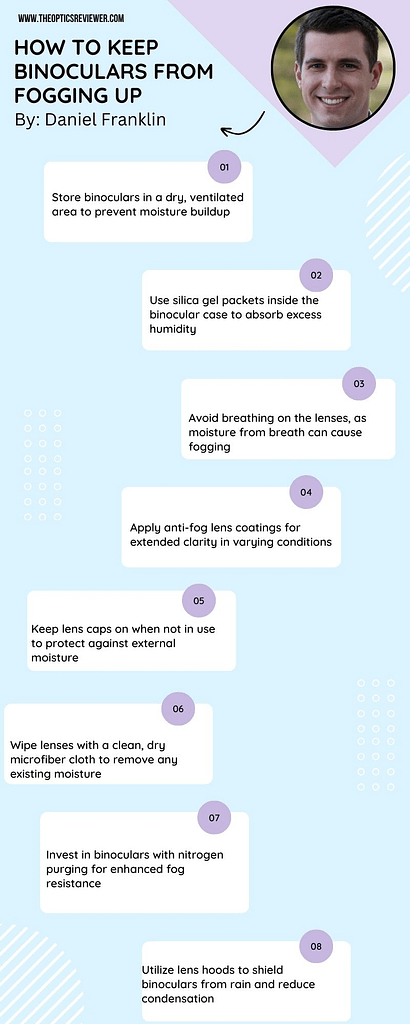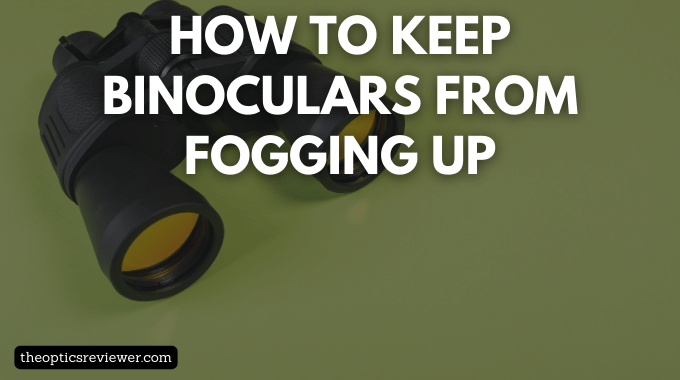Are you an outdoor enthusiast always ready to accomplish something new, discover new terrains, see the beauty of nature, and observe wildlife in all its glory? What if your trip experience is disrupted by faulty gear, like a foggy pair of binoculars? Seems perplexing, Right? Binoculars are good at focusing objects in front of the viewer. But there are times when this is not enough, and the background becomes misty and blurry. This is called binocular fog.
So now you will be thinking about how to keep binoculars from fogging up, firstly you are not alone in facing this problem, as the binocular fog is a problem that affects many people who use binoculars for different purposes, including athletes, photographers, hikers, and hunters. You need not worry as we will thoroughly discuss several ways to solve this problem. But before discussing how to keep binoculars from fogging up, let us first discuss the reason for binoculars’ fog.
Contents
- 1 Key Takeaways
- 2 Why Do Binoculars Fog Up?
- 3 How To Keep Binoculars From Fogging up?
- 4 Conclusion
- 5 References
- 6 FAQs
- 6.1 How Do You Fix Foggy Binoculars?
- 6.2 What To Do in Case You Spot Mold in Your Binoculars?
- 6.3 Are Fog-Proof Binoculars Worth The Money?
- 6.4 Can You Use Chemicals to Clean Your Binoculars?
- 6.5 What Should You Rub on The Inside Of Your Safety Goggles To Prevent Fogging?
- 6.6 How Do You Make Homemade Goggle Defogger?
- 6.7 How Do You Permanently Defog Goggles?
Key Takeaways
- Apply anti-fog solutions or wipes designed for optics to prevent fogging on binocular lenses.
- Allow ventilation by keeping eyecups slightly extended to minimize temperature differences causing condensation.
- Store binoculars in a dry environment and use moisture-absorbing silica gel packets to prevent moisture buildup.
- Minimize temperature changes to prevent rapid condensation, and use lens hoods for additional protection.
Why Do Binoculars Fog Up?
Binoculars are prone to fogging up when they are subjected to abrupt changes in humidity or temperature. Moreover, moisture from the user’s breath can also result in fogging of binoculars. The little water droplets suspended on the surface of binocular lenses cause fog to appear and make things less visible.
It is worth mentioning that not only can the moisture accumulate on your lens’s outer surface, but it can also get into your binoculars’ assembly and result in inner condensation or fogging.

How To Keep Binoculars From Fogging up?
To prevent fogging, you should refrain from exposing your binoculars to even slight temperature variations. If your binos fog up, you should wipe the outer lens with a cloth or apply a specific gel (anti-fog treatments) to the lenses to help your binoculars reduce condensation. Moreover, you can use desiccants for dry storage of binoculars or fog-proof binoculars to avoid it altogether.
We will discuss how to keep binoculars from fogging up thoroughly, and we will discuss it in two parts, outer condensation and inner condensation.

1. Outer Condensation
Before diving deep into the solutions that can keep binos from fogging, let’s discuss outer condensation. So, it is a scenario where the ocular lens or the eyepiece of binoculars gets all foggy or misty due to temperature fluctuations or humidity. But you need not worry too much as in this scenario; no real harm is done to the binoculars assembly.
Letting The Binos Adapt to Temperature Changes
So first thing first, you can start by letting your binos adapt to the temperature fluctuations on their own, like letting the binoculars acclimate for at least 15 minutes prior to usage or leaving them in the truck overnight if you are going to use them in the morning. This gives the binos enough time to accommodate the surroundings. It is worth mentioning that, no doubt, this method seems like an easy approach, but it is far less beneficial than other techniques of keeping the binoculars from fogging up and does not guarantee good results every time.
It is worth mentioning that fog can also be caused by body heat and warm breath. One technique to keep it from happening is to press your breath downward while tucking your upper lip over your bottom lip. Moreover, you can fully retract the eyecups to prevent steam build-up, as this keeps the eyes farther away from the eyepieces.
If interested you can read more about best binoculars under 500.
Anti-Fog Treatments
So, when it comes to outer condensation, that is quite a common scenario; the solution is simple: using anti-fog treatments. Binocular lenses can be made fog-free by using certain gels or solutions. When using anti-fog treatments, you should be careful since while they can significantly reduce the amount of misting on your binoculars’ outer lenses, they rarely last long enough and have little or no effect on condensation inside them.
Before using an anti-fog solution, clean your lenses and give the solution a good shake before spraying it on your binoculars. Once you have applied the anti-fog solution to your lenses, waiting for a minute or two before wiping off the solution is generally advised. Afterward, it would be best if you use a dry, lint-free cloth to clean lenses. Once the lenses are dry, you can safely use your binoculars.
Use a Soft Cloth
You can use the cloth included in your binocular package to eliminate the outer condensation on your eye relief binoculars. But it’s not the only way to do it, as you can use a microfiber towel to get rid of the outer condensation of your binoculars. Before storing the binoculars, please keep them in a warm, dry area to dry off.
When cleaning your binoculars, ensure you do not use abrasive products like sandpaper, as these can scratch the lenses and cause them to deteriorate quickly.
Now once we have discussed the ways to prevent outer condensation, let us discuss inner condensation.
If interested you can read more about parts of binoculars.
2. Inner Condensation
Water droplets can condense inside the binoculars owing to temperature fluctuations, producing hazy images, and it is known as inner condensation.
Buy Fog-Proof Binoculars
When it comes to the inner condensation, that is a real problem, and that’s where you cannot do much apart from waiting for the binoculars to clear themselves. But then again, there is something which you can do, and that is to buy a pair of binoculars that are waterproof and fog proof, O-ring sealed, and purged with some inert gas like nitrogen or argon.
Argon gas has larger molecules as compared to nitrogen gas, so it has better retention power. Hence, there are more chances of nitrogen leaking out after a shock or impact than argon, making the unit susceptible to water damage. However, argon purging is more expensive than nitrogen purging.
By purging binoculars with an inert gas like nitrogen or argon, you may avoid internal fogging, provide a waterproof environment, and avoid mold and fungus growth. Thus, binoculars marketed as “fog-proof” are filled with inert gas to replace any naturally occurring oxygen and prevent moisture build-up, which otherwise can cause the binoculars to fog up and even foster mold growth or mildew.
It is worth mentioning that not only the “waterproof” and “fog-proof” binoculars are purged with inert gas, but after purging to further prevent any moisture build-up, the binoculars are sealed (O-ring sealed). The nitrogen or argon-purged binoculars are made waterproof during sealing, preventing moisture from gathering around the lenses, thus halting mold and fungus growth.
Use a Desiccant
Suppose you cannot buy a pair of fog-proof binoculars and now are wondering how to keep binoculars from fogging up. In that case, you can take a few preventive measures, as spy binoculars should ideally be stored in a plastic bag or an airtight container with desiccant-like silica gel packets. What these desiccants do is that they absorb all the moisture that got its way into your binoculars.
Moreover, if the moisture somehow gets its way into your binoculars assembly, again, you can use a desiccant like uncooked rice or silica gel to eliminate such problems. So you must take a desiccant of your choice, like uncooked rice, in a zip-lock bag and submerge your binoculars. Seal the bag and let it be for about 24 hours. Mostly, you will get the desired results in 24 hours, but in case of severe moisture problems, it can take longer.
Ensure Dry Storage
A high humidity, high temperature, or dusty environment is not a good place to store binoculars. Moreover, at all costs, you should avoid subjecting them to a humid environment and high temperatures like over 90 degrees Fahrenheit or 32 degrees Celsius, as this may potentially harm their quality.
It is worth mentioning that if condensation builds up frequently inside binoculars, it may result in dripping on the interior glass, drops of water, or fungus or mold, all of which may harm the binoculars’ quality. You should send the binoculars to qualified personnel or shop for thorough cleaning if you suspect any of those things happened.
If interested you can read more about best binoculars for elk hunting.
Conclusion
We hope you have understood the key points of how to keep binoculars from fogging up. It’s essential to take care of your binoculars from any potential problems that could result in subpar images because, in the first place, you invested in the binos to enjoy the beauty of nature around you.
To cut a long story short, we have thoroughly discussed how to keep binoculars from fogging up and take care of them, but if the moisture built up is really high or there is mold in your binoculars, it is always better to seek professional help.
Have a nice day!
References
- https://core.ac.uk/download/pdf/212800020.pdf
- https://link.springer.com/article/10.1007/BF00230199
- https://www.jstor.org/stable/1414463
- https://www.cell.com/neuron/pdf/S0896-6273(21)00158-6.pdf
FAQs
How Do You Fix Foggy Binoculars?
To prevent fogging, you should refrain from exposing your binoculars to even slight temperature variations. If your binos fog up, you should wipe the outer lens with a cloth or apply a specific gel (anti-fog treatments) to the lenses to help your binoculars reduce condensation. Moreover, you can use desiccants for dry storage of binoculars or fog-proof binoculars to avoid it altogether.
What To Do in Case You Spot Mold in Your Binoculars?
Suppose you have left your binoculars in a humid environment for too long without any care or precaution. In that case, mold or fungus growth on your binoculars lens is an inevitable phenomenon.
When fungus or mold first appears in your binoculars, it may already be advanced to the point where it has dispersed spores into the minuscule crevices of the entire inner assembly. Since this will require disassembling the binoculars, we advise you to seek professional assistance.
Are Fog-Proof Binoculars Worth The Money?
Absolutely, investing in fog-proof binoculars with inert gas purging, such as nitrogen or argon, is worthwhile. This process not only prevents internal fogging but also creates a waterproof environment by replacing oxygen and sealing the binoculars with O-rings, preventing moisture buildup and inhibiting mold and fungus growth around the lenses.
Can You Use Chemicals to Clean Your Binoculars?
Lens cleaning products made especially for optics and lenses are available in the market, and you can use them to get rid of the moisture that got its way into your binoculars. Another popular product included in lens cleaning kits is dry-cleaning chemicals without alcohol. Still, you should make sure to carefully read the associated instructions so that you apply the solution correctly.
What Should You Rub on The Inside Of Your Safety Goggles To Prevent Fogging?
To prevent fogging, apply an anti-fog solution or a small amount of dish soap on the inside of your safety goggles.
How Do You Make Homemade Goggle Defogger?
Mix equal parts of white vinegar and water, apply the solution to your goggles, and then rinse them thoroughly. This homemade defogger helps prevent fogging and ensures clear vision during various activities.
How Do You Permanently Defog Goggles?
To permanently defog goggles, apply a small amount of toothpaste or a commercial anti-fog solution to the inner surface. Rub it gently, then rinse and let them air dry. This creates a thin, protective layer that prevents fogging.

